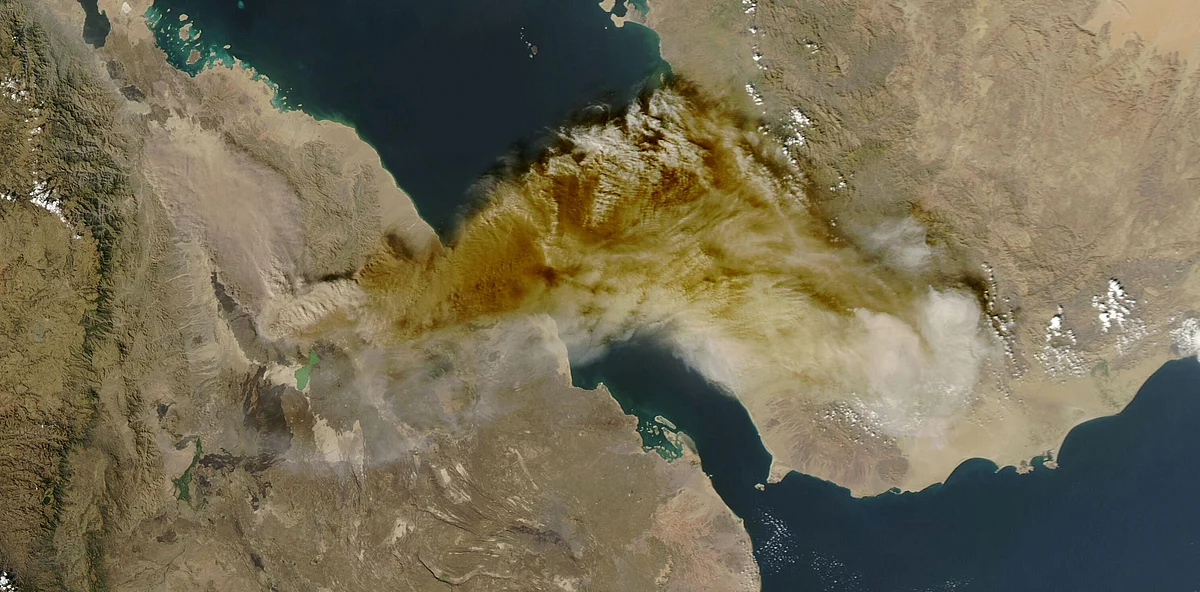
Explained: Why A Volcano Thousands Of Kilometres Away Can Shut Down Global Airspaces
Volcanic ash from the Hayli Gubbi eruption has disrupted operations from India to multiple countries, including the UAE. Authorities in Oman and Saudi Arabia said they are tracking the plume as it moves across regional airspace.
Ash may look like ordinary smoke from the ground but is actually a mix of tiny rock and glass particles, explained Muhammad Siddique, a GCAA licensed flight dispatcher, in a LinkedIn post.
Recommended For You“When an aircraft flies through it, the engines can choke, the cockpit windows can get sandblasted, and the sensors that guide the pilots can become unreliable,” he said. Even a small ash cloud can force flights to divert or stay grounded because the aircraft may not detect the material until it is too late.
Stay up to date with the latest news. Follow KT on WhatsApp Channels.
The ash cloud has already caused operational challenges on several routes. An Abu Dhabi-bound IndiGo flight was diverted to Ahmedabad on November 24 due to the volcanic activity.
Giuseppe Lo Turco, an aviation project developer and airside operations specialist, said volcanic ash acts like a“weapon of destruction” for engines. He explained that ash particles melt inside the high temperature turbine sections, forming a sticky layer that can block exhaust flow and shut down engines.
Before melting, he said, the particles erode cockpit windshields, compressor blades and critical instruments.“Since it cannot be detected by conventional weather radar, ash is an invisible threat that requires the immediate and preventive closure of airspace,” he said.
Hayli Gubbi is part of the Erta Ale volcanic range and had been dormant for nearly 10,000 years. Al Jarwan told Emarat Al Youm that the eruption sent a dense ash plume more than 10 kilometres high, visible on satellite imagery and atmospheric monitoring platforms.
The movement of ash and sulphur dioxide towards Yemen and Oman may temporarily reduce air quality in some areas and can produce light acid rain when the gas reacts with moisture.
The eruption has already reached aviation altitudes near 20,000 feet, allowing the ash to spread across long distance routes used by airlines between Africa, the Gulf, South Asia and beyond. The volcano rises about 500 metres within Ethiopia's Rift Valley, a zone of intense geological activity where two tectonic plates meet.
The blast produced a towering column of ash that drifted across the Red Sea, with concentrations of volcanic material detected in Oman. A UAE expert earlier told Emarat Al Youm that drifting sulphur dioxide can react with moisture and produce light acid rain.
Oman's Environment Authority confirmed that monitoring stations had not recorded any increase in pollutant levels and said there was no impact on public health.
Al Jarwan said the eruption carries environmental and health hazards. He said volcanic ash warning centres issued alerts to civil aviation because fine particles can affect aircraft engines, visibility and navigation systems. Authorities in the area advised residents not to approach the volcano or inhale contaminated air.
Aviation routes over the Red Sea and surrounding regions may also be affected until conditions stabilise. Saudi Arabian authorities also said they are monitoring atmospheric conditions for any effect.
The ash cloud has already caused operational challenges on several routes. An Abu Dhabi-bound IndiGo flight was diverted to Ahmedabad on November 24 due to the volcanic activity. Flights from India to the Gulf and other destinations experienced delays or cancellations as airlines adjusted paths to avoid the affected air corridors.
Local carriers Emirates, Etihad Airways, and flydubai said on Tuesday their operations were running normally, including flights to Addis Ababa. The airlines told Khaleej Times they are monitoring the situation and asked passengers to keep their details updated for any changes in the flight schedule.
Volcanic ash is especially dangerous because it does not stay confined to the eruption zone. Hans-Georg Rabacher, a pilot and aviation author, said ash can be carried by high altitude winds far beyond the source, meaning it is“by no means a local phenomenon". He said an ash cloud can“travel thousands of kilometres", reaching airspaces with no direct geographic link to the volcano and forcing sudden detours or closures as conditions shift.
Rabacher said visibility is another major concern because the particles act like an abrasive on aircraft windows. He explained that ash can“scratch the cockpit windows or turn the outer panes cloudy to the point of near opacity", sharply reducing what pilots can see.
Even a short encounter with volcanic ash can leave visibility compromised, he said, which is why aviation authorities move quickly to restrict flights when ash is detected at cruising altitudes.

Legal Disclaimer:
MENAFN provides the
information “as is” without warranty of any kind. We do not accept
any responsibility or liability for the accuracy, content, images,
videos, licenses, completeness, legality, or reliability of the information
contained in this article. If you have any complaints or copyright
issues related to this article, kindly contact the provider above.


















Comments
No comment